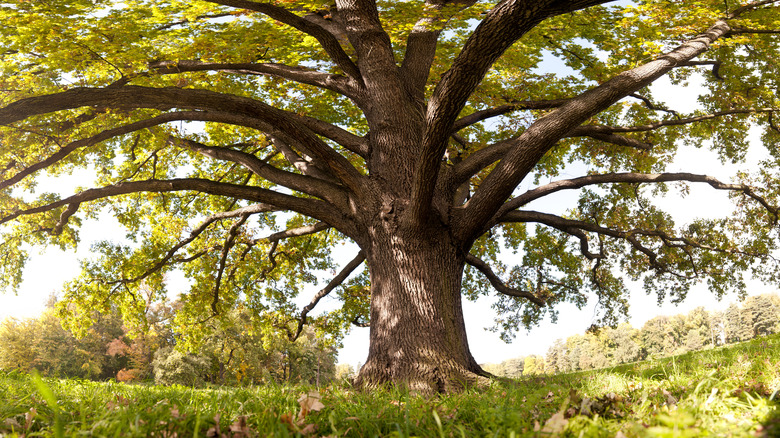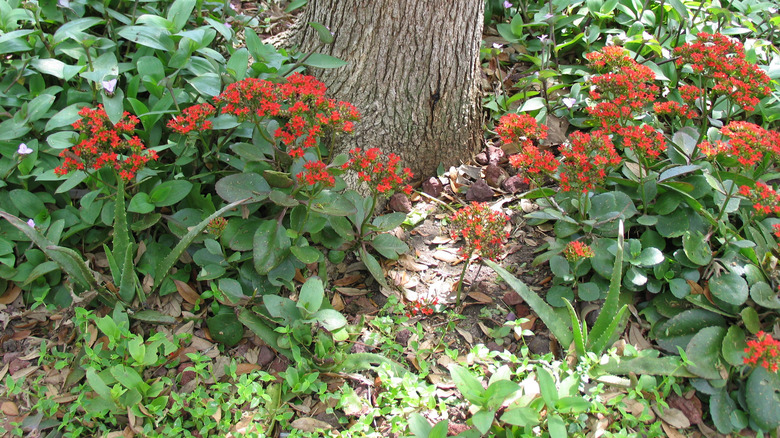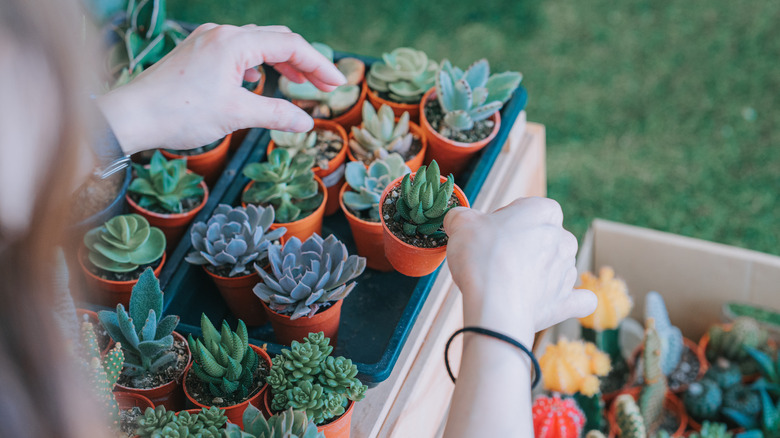The Stunning Companion Plant That Will Thrive Under Your Oak Tree
Oak trees are some of the most iconic and beloved trees in North America. In a yard or garden, no matter what variety they are, these trees are excellent for providing shade, retaining water, improving soil health and stability, and adding visual interest. They also serve an extremely important role in the environment, providing food and shelter to many life-forms. However, learning how to grow and care for oak trees can present some challenges when it comes to gardening. Oak trees won't appreciate having their roots disturbed or fertilized, and they don't like to receive much water during the summertime. Because of this, it's best to avoid companion planting oaks with flowers and herbs that need frequent fussing. Instead, you'll want to opt for plants that are more than happy to be ignored in the summertime — and there are few plants that tolerate gardener neglect better than succulents.
Succulents are often treated as full-sun desert plants, but they can actually be quite happy in the dry, shady conditions under an oak tree. Furthermore, this category of plants provides plenty of different options for types of greenery you could include underneath your oaks. Here's why succulents and oak trees are a match made in heaven and tips for helping these companion plants thrive together.
All sorts of succulents make great companions
While they are very different plants, the environmental needs of succulents and oaks are really quite compatible. Oak trees have very deep root systems which can be more than triple the size of the tree's canopy. By contrast, succulents tend to have shallow roots that extend horizontally, and they hold most of their moisture in their leaves and stems. Because of this, succulents really have no interest in competing with the mighty oak tree for water, so both can live quite happily beside each other.
In some ways, the oak tree may even provide some benefits for tender succulents. Although they generally like the sun, succulents are prone to sunburn, especially in hot and dry conditions. Partial shade from an oak tree can be a lifesaver for these little succulents in the summer, especially during the hottest, brightest hours of the day. In winter, the tree may also provide some shelter from cold rain and frost, encouraging succulents to go dormant instead of dying in the cold.
Aside from their functional compatibility, oak trees and succulents just look good together! The contrast between succulents' plump, vibrant leaves and the oak tree's rough, bumpy bark is appealing to the eye and can make the space beneath your oak tree feel much more alive and inviting. There are even many succulents that will bloom with dramatic purple flowers for a colorful touch.
Selecting and growing plants under your oak
In general, succulents can be a good companion plant for oaks, but some varieties will be better suited than others. Some beautiful shade-loving succulents include Christmas cactus, Easter cactus, kalanchoe, fox tail agave, devil's backbone, panda plant, and aloes. If succulents just aren't your thing, try planting azaleas, California fescue, creeping sage, or hostas. Practically any low-maintenance and drought-tolerant plants will do. For areas that peak out from the dripline of the tree, you can opt for more full-sun plants as well as those with slightly-deeper roots.
When it comes to growing succulents (or any other plants) under your oak trees, the best thing you can do is leave both of them alone as much as possible. You'll need to avoid watering your oak trees in summer, as the hot conditions and moist soil can lead to fungal overgrowth and root rot. Once established, succulents are drought-resistant plants that survive without much water, even in summer. If you're really not sure how your plants will fare under the oak tree, try planting them in containers first and placing them under the tree for at least a few weeks. This will avoid the risk of disturbing the oak's roots while also testing how well the succulents do in partial shade before making a commitment. It is also important to check the USDA Hardiness Zone map to ensure that succulents will thrive in your climate.



